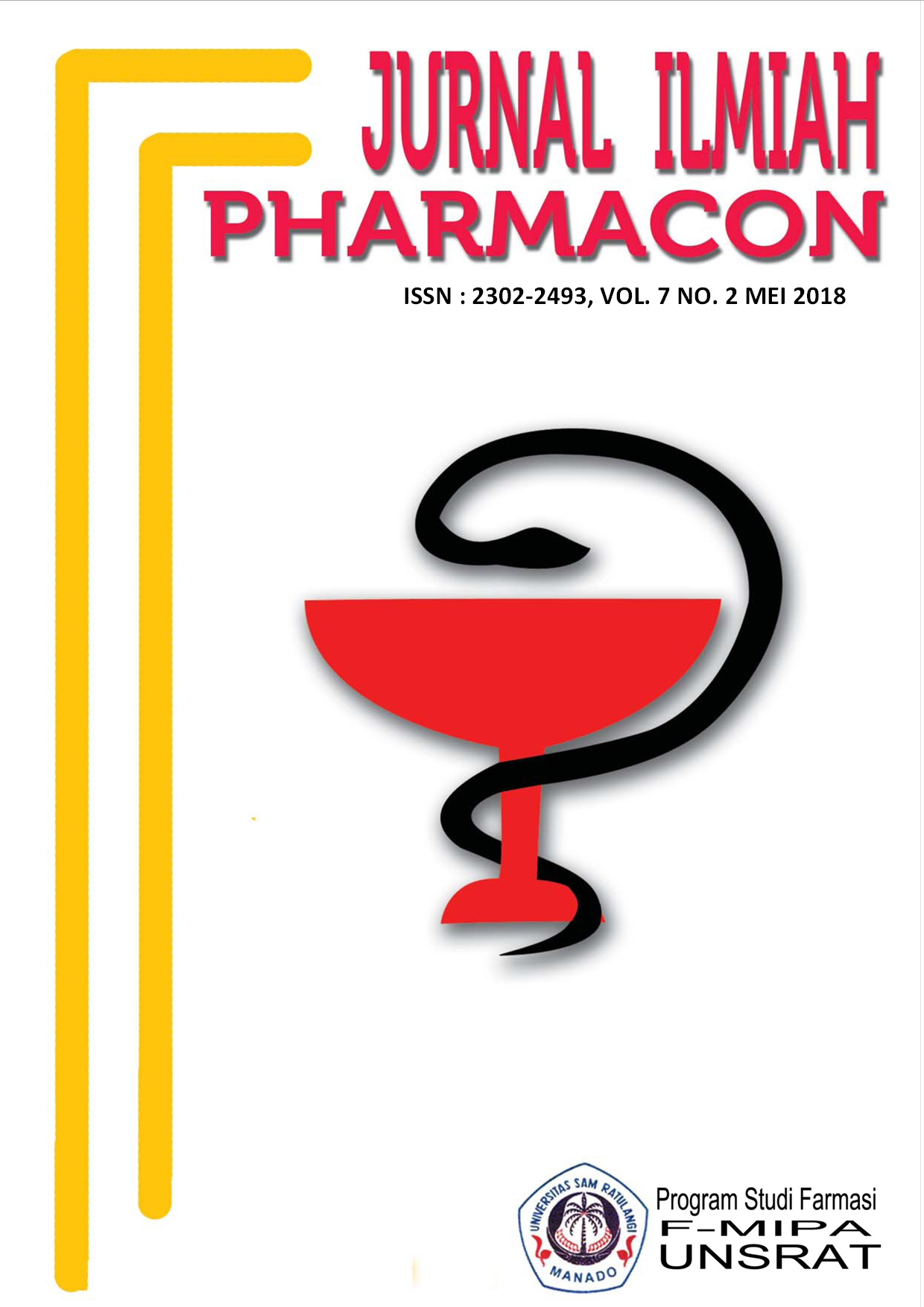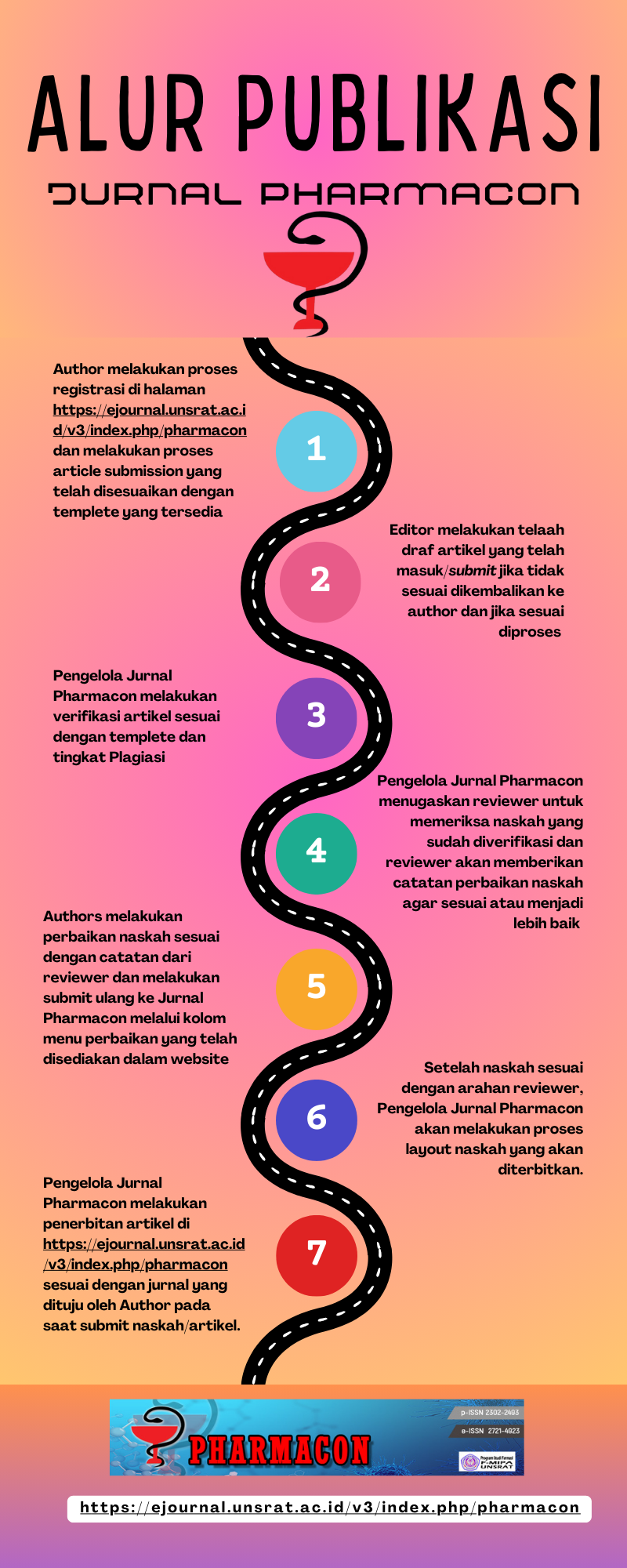ISOLASI, IDENTIFIKASI SECARA MOLEKULER MENGGUNAKAN GEN 16S rRNA, DAN UJI AKTIVITAS ANTIBAKTERI BAKTERI SIMBION ENDOFIT YANG DIISOLASI DARI ALGA Halimeda opuntia
DOI:
https://doi.org/10.35799/pha.7.2018.19509Abstract
ISOLASI, IDENTIFIKASI SECARA MOLEKULER MENGGUNAKAN GEN 16S rRNA, DAN UJI AKTIVITAS ANTIBAKTERI BAKTERI SIMBION ENDOFIT YANG DIISOLASI DARI ALGA Halimeda opuntia
Â
Castly Herny Rau1), Adithya Yudistira1), Herny E. I. Simbala1)
1)Program Studi Farmasi FMIPA UNSRAT Manado, 95115
Â
ABSTRACT
           Algae is one of the primary producers in marine ecosystem whose existence in Indonesia is quite abundant. Algae is the living place of various microorganisms that are symbiotic with it, included bacteria. Endophytic symbiont bacteria of algae has potential as a candidate of antibiotic producing agent, because it is able to produce bioactive metabolite that can inhibit the growth of pathogenic bacteria. The objective of this study is to isolate and test the antibacterial activity of endophytic symbiont bacteria of Halimeda opuntia, and to carry out molecular identification using 16S rRNA gene to identify the endophytic bacteria isolate that showing the greatest antibacterial power. A total of 3 isolates of endophytic symbiont bacteria were obtained through the purification process. The results of antibacterial activity test showed that all the supernatants of endophytic simbiont bacteria isolates had inhibitory activity against the growth of pathogenic bacteria. The mean diameter of the inhibitory zone against Escherichia coli were: Ho-B1 (6.86 mm) and Ho-B2 (8.53 mm) classified as intermediet, and Ho-B3 (4.36 mm) classified as weak. While the antibacterial activity against Staphylococcus aureus bacteria were: Ho-B1 (6,15 mm) and Ho-B2 (6,84 mm) classified as intermediet, and Ho-B3 (3,84 mm) classified as weak. The Ho-B2 isolate which had the highest inhibitory index in the antibacterial activity test was identified molecularly as Bacillus sp.
Â
Keywords        : Halimeda opuntia, endophytic symbiont bacteria, isolation,
 antibacterial activity, molecular identification, 16S rRNA gene
Â
Â
ABSTRAK
Alga merupakan salah satu produsen primer di ekosistem perairan laut yang keberadaannya di Indonesia ÂÂcukup melimpah. Alga merupakan tempat hidup berbagai mikroorganisme yang bersimbiosis dengannya, salah satunya ialah bakteri. Bakteri simbion endofit alga berpotensi sebagai kandidat agensia penghasil antibiotik, karena mampu menghasilkan metabolit bioaktif yang dapat menghambat pertumbuhan bakteri patogen. Penelitian ini bertujuan untuk mengisolasi dan melakukan pengujian aktivitas antibakteri dari bakteri simbion endofit alga Halimeda opuntia, serta melakukan identifikasi secara molekuler menggunakan gen 16S rRNA terhadap isolat bakteri simbion yang menunjukkan daya antibakteri terbesar. Sebanyak 3 isolat bakteri simbion endofit berhasil diperoleh melalui tahap purifikasi. Hasil pengujian aktivitas antibakteri menunjukkan bahwa supernatan ketiga isolat bakteri simbion endofit memiliki aktivitas penghambatan terhadap pertumbuhan bakteri uji. Diameter rata-rata zona hambat terhadap bakteri Escherichia coli yaitu: Ho-B1 (6,86 mm) dan Ho-B2 (8,53 mm) tergolong kategori sedang, dan Ho-B3 (4,36 mm) tergolong kategori lemah. Sedangkan daya antibakteri terhadap bakteri Staphylococcus aureus yaitu: Ho-B1 (6,15 mm) dan Ho-B2 (6,84 mm) tergolong kategori sedang, dan Ho-B3 (3,84 mm) tergolong kategori lemah. Isolat Ho-B2 yang memiliki indeks penghambatan tertinggi dalam pengujian aktivitas antibakteri teridentifikasi secara molekuler sebagai Bacillus sp.
Â
Kata kunci     : Halimeda opuntia, bakteri simbion endofit, isolasi, aktivitas
 antibakteri,   identifikasi molekuler, gen 16S rRNA
Â
Downloads
Published
How to Cite
Issue
Section
License
Authors who publish with this journal agree to the following terms:
- Authors retain copyright and grant the journal right of first publication with the work simultaneously licensed under a Creative Commons Attribution-NonCommercial 4.0 International License that allows others to share the work with an acknowledgement of the work's authorship and initial publication in this journal.
- Authors are permitted and encouraged to post their work online (e.g., in institutional repositories or on their website) prior to and during the submission process, as it can lead to productive exchanges, as well as earlier and greater citation of published work (See The Effect of Open Access)










